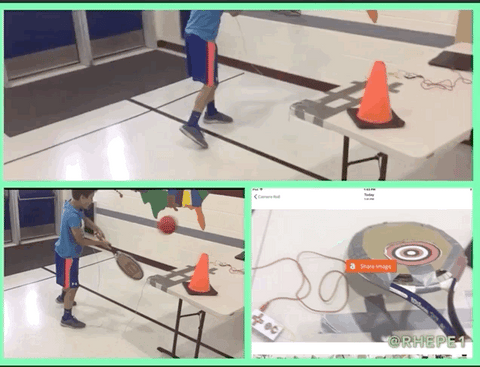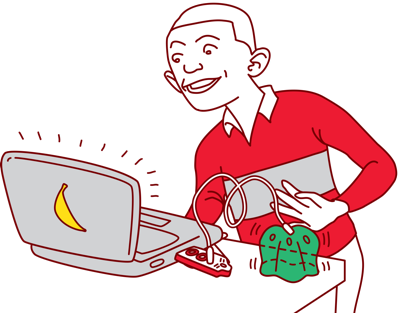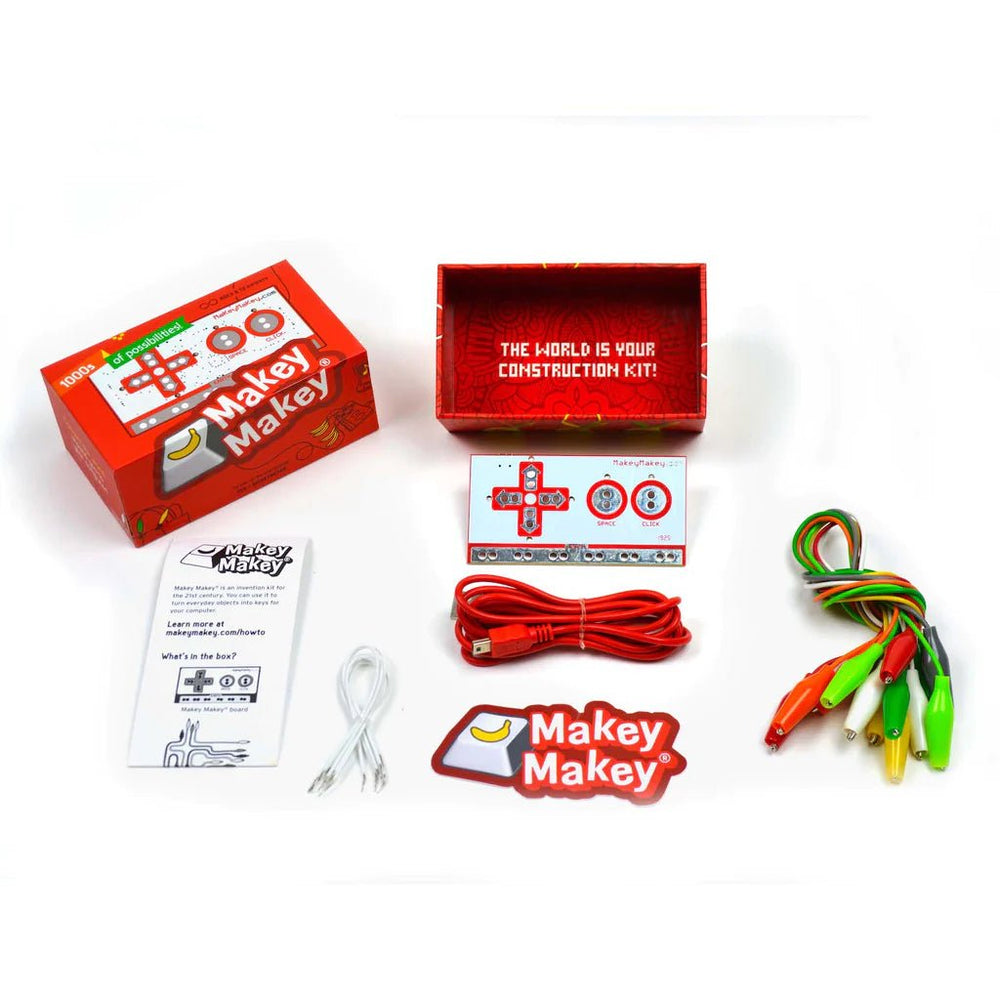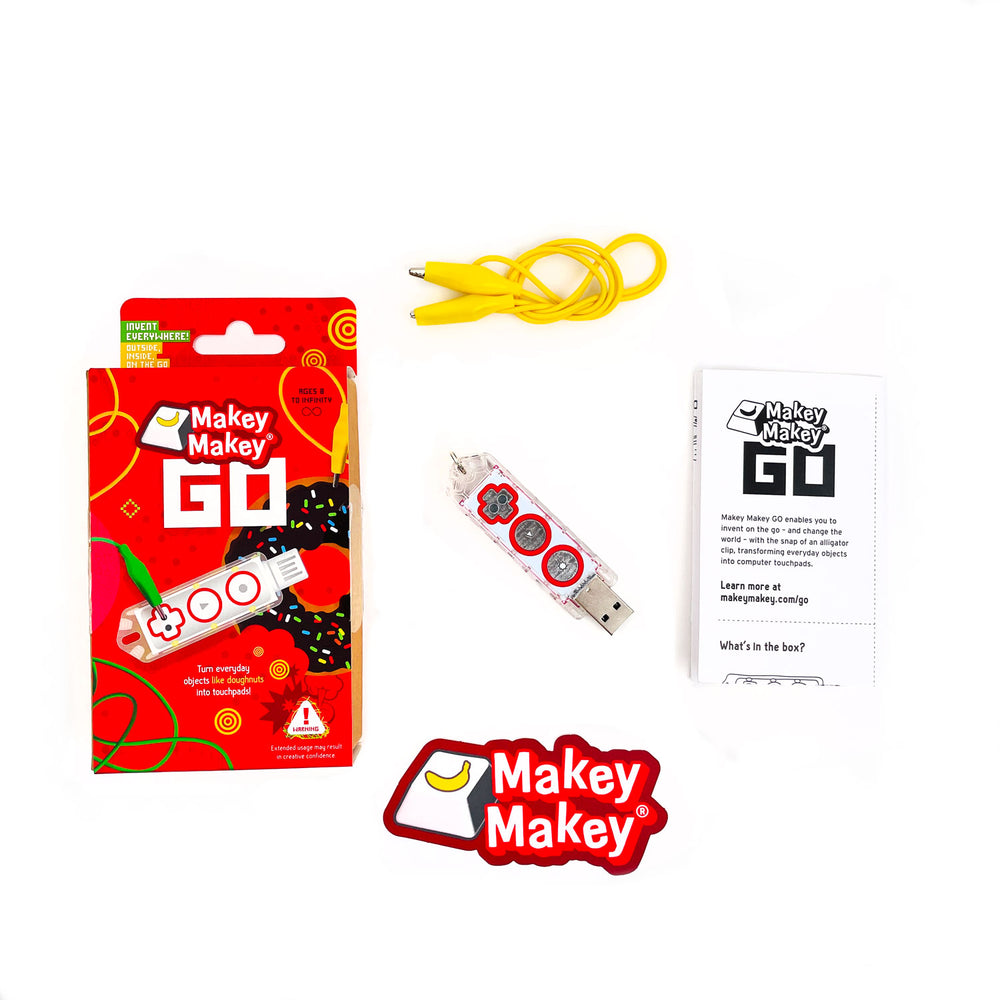Featured Educator: Eric Turrill and STEM in the Gym
We love the innovative ways that educators (in both formal and informal learning spaces) introduce learners to the concept of physical computing with Makey Makey and coding languages like: Scratch, Processing, and Python. Each month, we will feature an educator and a unique project they've worked on recently. To read more educator posts, simply sign up for our newsletter and we'll guide you to our best content.
Meet this month's featured educator: Eric Turrill from RoundHill PE!
Last summer we were wowed by Eric’s Makey Makey STEM in the gym activities. So much so that we went to a local school and challenged kids to make their own STEM in the gym activities with Makey Makey and Scratch. Check out these 16 great activities designed by Eric and his students!
Tell us a little about your school.
Eric: Eric: I work at Round Hill Elementary in Northern Virginia which is about an hour and a half from Washington DC. Our proximity to DC, means a lot of our parents work in government fields or technology. As one of the 15 coding schools in Virginia, our 580 students are part of a computer science immersion as part of a national program called “Code to the Future.” This means that our students code 30 minutes everyday. Throughout the year our students learn Scratch, robotics, Sphero, and even tie coding in with Project Based Learning.
What is your role on campus?
Eric: I work at Round Hill Elementary in Northern Virginia which is about an hour and a half from Washington DC. Our proximity to DC, means a lot of our parents work in government fields or technology. As one of the 15 coding schools in Virginia, our 580 students are part of a computer science immersion as part of a national program called “Code to the Future.” This means that our students code 30 minutes everyday. Throughout the year our students learn Scratch, robotics, Sphero, and even tie coding in with Project Based Learning.
What is your role on campus?
Eric: I not only teach a Physical Education, but I run the morning TV show. Our fifth grade students have the opportunity to run the camera, teleprompt, be news anchors,the broadcast software, etc. I also have a 5th grade crew that helps me broadcast all of our assemblies. We use Zoom in the morning to live stream kids coming in to school to share what is going on in school in the morning all over the building. It is a neat way to utilize technology to build our school community.
In every lesson in my PE classes,Technology helps me to create visuals, which help maximize learning since my classes are only 30 minutes long. I project warm ups, the lesson, GIFs to teach a specific skill, activity layouts and rotations. Technology allows me to be a better teacher. One app I really like to use is the Vclone app, it lets me show four different clones of myself teaching something like step aerobics or fitness exercises. By incorporating technology into my program I am engaging the students and therefore enhancing learning.
Technology has also helped my grow as an educator. In many schools, the PE teacher is the only PE teacher in their school. Physical Educators can become isolated within the four walls of their school. Technology has helped me connect with other like-minded educators around the globe on a nightly basis. Through Twitter, YouTube, Facebook, and online conferences, I can see what other amazing lessons are being taught by some of the best teachers around the globe on a nightly basis.

We went bananas last year when you posted your STEM in the gym ideas. How did you come up with them all?
Eric: It was a slow process! While physical education may not be for every child, movement is for every child. STEM in the gym is for every kid! Because kids can manipulate, create, play, and explore, every student can find a connection when we do STEM in the gym activities.
Two months leading up to my summer camp, my school received a grant for 30 Makey Makeys. Our 4th grade and 5th grade teachers took Makey Makey into their class and were exploring different ways to incorporate this device into innovation lab time. I was talking with Mrs. Parker and (?) and she was using this external device that you could plug into the computer and do whatever you wanted with it! I was intrigued and wondered:
“How can I use these Makey Makeys for our STEM in the gym summer camp?”
So I spent two months researching how people were using Makey Makey in their own classes. Once I had the basic idea, I just thought, “How I can add movement with this creative little device?”
I developed four activities for our camp, where kids would make a connection and a bears roar, because we are the Round Hill Bears, would come across the computer or another noise, and after the first day, I asked the kids to think:
“What are some movement based things that we can use to make a roar sound, or a counter, or ding, or movement?”
“What are some movement based things that we can use to make a roar sound, or a counter, or ding, or movement?”
From there we worked on 12 other ideas together and now you can try out those 16 ideas! Here is a link to the slideshow that accompanies the Youtube video!
- Plank Walk Challenge: Uses this online counter or this tally counter


- Scooter Musical Challenge: How many kids can scoot through? This pairs nicely with Makey Makey Bongos!

- Human Piano Challenge: Works well with the Makey Makey Piano

- Straddle Jump Challenge: Works with online counter or this tally counter

- Basketball Around the World Challenge

- Arrow Jumping Challenge: We used this Cool Math Game.

- Racket Skills Challenge: Crowd Cheering Sound Effect in Scratch

- Frogger Challenge: Online Frogger Game
- Iron Man vs Pac-Man Challenge: Scratch Game
- Pac-Man Challenge: Online Pacman Game

- Step Counter Challenge: Uses this online counter or this tally counter

- Musical Oranges & Water Bowls Challenge: Makey Makey Piano

What are some other ways you incorporate STEM in the gym?
“STEM in the gym” is about combining kinesthetic learning with STEM and we started it about four years ago. Our first year, we used simple machines to teach engineering, force, etc and combined those concepts with our PE equipment.
For example: We explored how a golf club wedge angles a ball on impact. We experienced how pulleys make work easier by pulling ourselves on carpet squares vs. scooters. We studied the force needed to roll a punching bag up an incline onto a platform vs just lifting the punching bag onto the platform. Through trial and error, we discovered the best angle to roll a ball down an inclined PVC pipe to maximize distance.
Another fun STEM in the gym activity we did during camp was making our own robotic hands out of cardboard.
STEM Camp Day 4. Making Robot Hands. Culminating activity after studying levers & pulleys. #physed #rhes16 pic.twitter.com/uEYCOGYDJq
— Round Hill P.E. (@RHEPE1) June 23, 2016
If you look at your hand, and your fingers, you will see you have three different bones. There are muscles that help your fingers move in and out.
For this activity, I cut out cardstock hand shapes, cut drinking straws to small 1/2 inch pieces, five 15 inch pieces of kite string, and then taught students to tape the straws in the right place to match the bones and muscles of a hand. Then when students added the kite string, the cardboard would mimic the behavior of a hand. We actually combined our ideas learned from simple machines into building our own robotic hand! To further challenge students, we asked them to use the hand to transport a yarn ball from one table to another table 10 feet apart.
What educators inspire you?
My first PE teacher Barbara Eason, taught me that all students are different and that all students learn in different ways. You can’t roll out the same lesson, you have to differentiate for every kid to have success.
Mark Panku- Taught me about brain research and learning styles and how that affects students success in physical education and the classroom.
I follow so many awesome #PEGeek physical educators like: Kevin Tiller, Jimmy Grassano, SupportREALteachers, Matthew Bassett, Physed, Ben Landers, Kyle.PE.Bragg, Becky Foellmer, and so many other wonderful, exciting physical educators.
For more STEM in the Gym Physical Education ideas or resources follow Eric on social!
- Round Hill Elementary Website - Round Hill, Virginia
- YouTube Channel
Thank you for your time, Eric! We love how your STEM in the gym Makey Makey activities help kids get creative and active!
STEM in the Gym Challenge Guide
Eric inspired us to create a guide to challenge students to create their own stem in the gym activities. Check it out and challenge your students to make their own STEM in the Gym activities!












